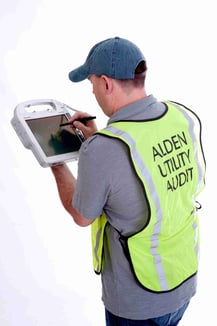C is for Capture: Asset Verification in the Field
 From first sight to final inspection, utility pole inspections are a vital part of successful field asset verification. So what really happens out there during assessment of equipment? Today, we take a look at the third step: Efficiently capture accurate field asset data.
From first sight to final inspection, utility pole inspections are a vital part of successful field asset verification. So what really happens out there during assessment of equipment? Today, we take a look at the third step: Efficiently capture accurate field asset data.
When a technician reaches the utility pole, he or she begins to capture a variety of data about the structure, as well as any standout characteristics that amount to a potential violation. Often, this is done using a handheld collection device that makes data entry for field asset management simple and organized.
A Standard Utility Pole Inspection
On a standard inventory, technicians capture many asset attributes. By no means an exhaustive list, a few typically captured attributes include:
- All utility pole attachments by type as well as information about each attachment owner
- Any pole numbers, including foreign pole number
- Structural information, including height class, material type, etc.
- Any number of company-required attributes
A standard inventory will also include documentation of the six most-seen utility pole violations. We have discussed a few of them recently.
- Missing guy markers
- Pole structural damage
- Abandoned lines or equipment
- Damaged or broken ground wires
- Mid-span vertical clearance issues
- Pole leaning
NESC-Specific
Finally, in addition to capturing the above items, a pole owner may request that the list of potential violations can be adjusted and expanded to include any number of things, including checks for explicit NESC violations:
- Minimal line clearance: During field asset verification, a technician will measure the distance between the lines (including drop lines) as well as any additional areas specified by NESC mandates to determine if minimal line clearance is being maintained around the pole.
- Proper grounding: The technician will perform an assessment to ensure that attaching parties are using proper grounding methods. This includes communication lines, guy lines, and other equipment.
- Verification of line burial: The technician will also verify that all of the lines going underground are buried and properly covered.This includes ground wires, communication lines and power lines.
- Secured equipment: NESC mandates require that the utility provider ensure that all guy wire lines are tight and all equipment is properly secured to the utility pole.
- Other violations, including pole climbing space, abandoned lines and equipment, damaged or broken poles, pole risers and tripping hazards may also be captured.
Overall, the inventory process is a valuable tool in the utility pole owner’s toolbox for a number of reasons, including that it offers owners a great deal of data about their assets. But data is just facts; it is the informed actions you take using the data that is meaningful.
With the help of a partner focused on field asset verification and with the use of intuitive field data capture software designed to organize, categorize, and make data accessible in ways that make seeing trends and issues over time possible. Asset verification can quickly turn into asset vindication, saving your company money and headaches regarding equipment out in the world.
What's Next?
D, for Define Pole Characteristics. As the technician gets up close and personal with each field asset, another set of data is also collected: pole-specific data that can offer a lot of information about the structure. It is our letter D—defining the pole’s characteristics—and the next article in this series covers this vital part of the utility pole inspection alphabet.
